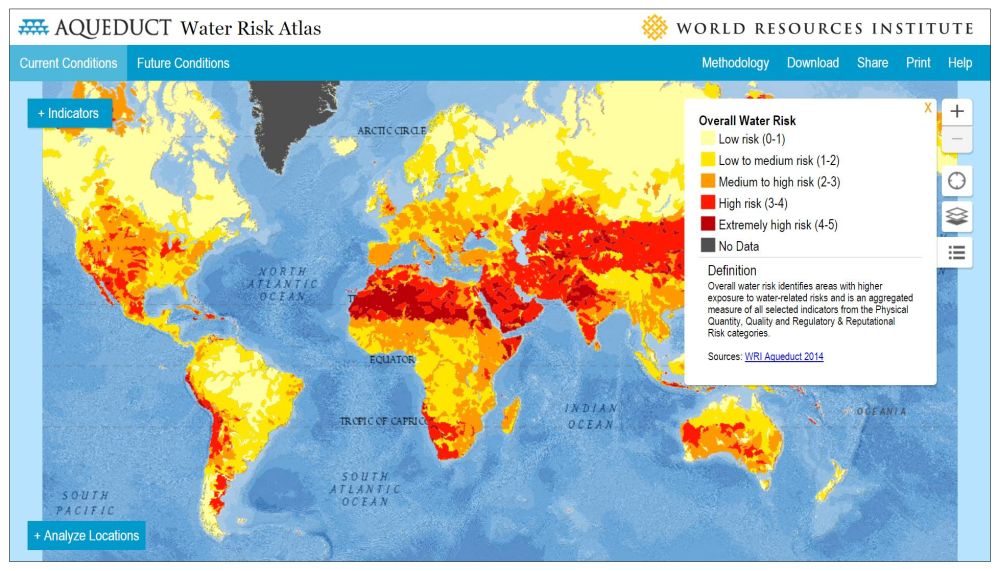‘WATER RISK ATLAS’ IS AN INITIAL SCREENING TOOL: “We’re currently facing a global water crisis. We’re likely to see more ‘Day Zeros’ in the future,” said Betsy Otto, Global Water Director, World Resources Institute (August 2019)
Not to Reader:
The World Resources Institute (WRI) has produced an Aqueduct Water Risk Atlas., WRI researchers used hydrological models and more than 50 years of data to estimate the typical water supply of 189 countries compared to their demand. The result was a scale of “water stress” — how close a country comes to draining its annual water stores in a typical year.
WRI is a global research organization that spans more than 50 countries, with offices in the United States, China, India, Brazil, Indonesia and more. More than 700 experts and staff work closely with leaders to turn big ideas into action to sustain our natural resources—the foundation of economic opportunity and human well-being. The WRI focuses on seven critical issues at the intersection of environment and development: climate, energy, food, forests, water, cities and the ocean.
Betsy Otto is the Director of WRI’s Global Water Program. Over the past several years at WRI, she has led development of Aqueduct™, a global water risk assessment and mapping tool to inform private and public sector investment and water management decisions.

Mapping the strain on our water
Water scarcity is one of the defining issues of the 21st century. In its Global Risks 2013 report, the World Economic Forum identified water supply crises as one of the highest impact and most likely risks facing the planet. With the support of a diverse group of partners, the World Resources Institute built Aqueduct to help companies, investors, governments, and communities better understand where and how water risks are emerging around the world.
“What is the next center of population and commerce to be roiled by a severely constricted water supply? It’s an urgent question,” wrote Brett Walton in an article posted on Circle of Blue.
 “It’s an existential question for cities,” Betsy Otto told Circle of Blue.
“It’s an existential question for cities,” Betsy Otto told Circle of Blue.
“Otto thinks about water risk in terms of chronic and acute. She likens the distinction to an ill person. Acute risks, like a heart attack that sends someone to the hospital, are an event that requires immediate attention. For a city’s water supply, low reservoirs can be a triggering event.
“Chronic risks are those that ultimately give rise to a crisis situation. Basic hydrology is one such factor. That chronic risk, depending on how a city responds to its environment, may not turn into an acute crisis, Otto said. But the risk is present.
“Aqueduct, the risk tool developed by World Resources Institute, is designed to identify areas that are exposed to chronic water stress. It is helpful as “an initial screening tool” for chronic risk, Otto said.”

The Situation in the United States
“The United States has enough water to satisfy the demand, but newly released data from the World Resources Institute shows some areas are out of balance,” wrote Bernie Berkowitz and Adrian Blanco in an article published by the Washington Post.
“The United States ranked 71st of 189 countries, and low-medium on the stress scale, meaning we are pulling out just under 20 percent of our available water.
“But within the country, the push-and-pull for water varies greatly.”
To Learn More:
To read the complete article published by Circle of Blue, download The Next Urban Water Crisis? Inadequate Data Clouds the Forecast
To read the complete article published by the Washington Post in August 2019, download Mapping the strain on our water.
Visit https://www.wri.org/resources/maps/aqueduct-water-risk-atlas and launch the interactive map.

Photo Credit: California © J. Carl Ganter/circleofblue.org (article by Brett Walton)

